Mobile phone solutions are now offered that respond intuitively to surroundings, giving complete control and unlimited connectivity for a wireless world—along with bilateral quality signals with normal phone positioning.
Phone calls with a mobile phone can be challenging for hearing instrument users, particularly when speech intelligibility is compromised by background noise. Furthermore, the proper and stable positioning of the mobile phone speaker in relation to the hearing instrument microphone has always been a problem.
Mobile phone solutions are now offered that respond intuitively to surroundings, giving complete control and unlimited connectivity for a wireless world. Click’nTalk was developed by Phonak for active hearing instrument wearers who want to benefit from a bilateral digital quality signal without background noise, while maintaining full mobility and normal phone positioning.

This article was submitted to HR by Myriel Nyffeler, PhD, a neurobiologist who serves as the international field study coordinator at Phonak AG, and Sven Dechant, an audiologist and validation manager in charge of conducting internal field studies at Phonak AG in Stäfa, Switzerland. Correspondence can be addressed to [email protected] or Myriel Nyffeler, PhD, at .
iCom is a new communication interface that can easily be used in combination with a TV, mp3 player, or mobile phone. With stereo-quality sound presentation, Bluetooth broadband audio streaming, and optional FM connection, the device offers wireless connections for other entertainment and communication devices. During a mobile phone call, iCom receives the Bluetooth signal from the cell phone and streams it wirelessly to the hearing instruments. iCom provides a binaural digital quality signal without background noise and allows hands-free telephone use.
Mobile Phones and Hearing Aids
It is often quite difficult to achieve optimum and stable positioning of the mobile phone near the hearing instrument microphones. Not only is it necessary to hold the mobile in an unnatural position over the microphones of a behind-the-ear (BTE) device, but there is also the possibility of inadvertently activating or adjusting operating elements of in-the-canal (ITC) devices when positioning the mobile phone.
Besides these positioning problems, hearing instrument wearers have difficulties due to reduced audibility and poor speech intelligibility resulting from hearing loss. Further, the sound quality of digital mobile phones suffers from reduced bandwidth of the speech signal and background noise during signal transmission. Many phones even have a low-quality speaker. Because of these problems, hearing aid users often use the mobile phone without hearing instruments, even though speech intelligibility is very poor without proper amplification.1-3
In addition, individuals with greater hearing loss are more likely to report feedback, distortion, and difficulty understanding speech with telephone use,4 as feedback may occur if the telephone is too close to the hearing instrument microphones. Acoustic, as well as telecoil, coupling may cause interference with the telephone signal, which may cause artefacts.5-11 Most recent studies indicate that 15% to 45% of hearing aid wearers are unable to use their aids while on the telephone.12,13
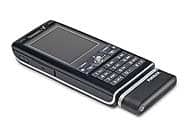
FIGURE 1. Click’n Talk for mobile phones.
The recent generation of Phonak hearing instruments, based on the CORE platform, are designed to not only function as separate devices, but also function as a system. This means that the hearing instruments can wirelessly transmit data to each other and to accessories, such as the iCom and Click’nTalk.
In the case of Click’nTalk, the highly robust digital transmission of the Hearing instrument Body Area Network (HiBAN) allows an increase of mobility with the mobile phone within the range of 25 cm, whereas conventional mobile phones allow a stable field of only about 0.5 cm for microphone and about 4 cm for mobile phones with a telecoil.
The wireless connectivity has been designed specifically for communication purposes, particularly taking into account all-day use. The chosen technology for the data and audio transfer between instruments is a coded digital electromagnetic field. Low-level electromagnetic fields are common to everyday equipment, such as televisions, telephones, computer monitors, and other consumer electronics.
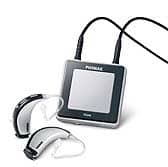
FIGURE 2. The iCom communication interface, which can be used with mobile phones, TVs, and mp3 players.
The CORE technology has a transfer rate of 300,000 bytes per second, using continuous phase frequency shift keying. The transmission frequency is 10.6 MHz with a bandwidth of 300 kHz. This frequency was chosen to be able to support the transfer of complex broadband data with virtually no interference. The magnetic field strength is far below the international maximum values and less than the field strengths of other everyday equipment, such as computer monitors, dishwashers, and halogen lamps.
The mobile phone/hearing aid interface devices. Click’nTalk (Figure 1) simply can be clicked into the mobile phone plug. It is powered by the mobile phone and therefore does not need separate batteries. No configuring of the mobile phone is needed, and the automatic hearing instrument program allows separate fine-tuning of the microphone and gain settings in the fitting formula (iPFG). The volume can be adjusted via the mobile phone volume button, which recognizes Click’nTalk the same way as a wired headset. Click’nTalk functions with all Phonak CORE devices.
iCom (Figure 2) provides a modern communication interface solution not only for mobile phones, but also in combination with TVs, laptops, mp3 players, GPS, and HiFi systems. iCom supports Bluetooth to allow audio to be wirelessly received from many different audio devices and transmitted to the subject’s hearing instruments. The neck loop along with the directional microphones ensures the speaker’s voice is optimally picked up and transferred to the mobile phone, even if the phone is stored in the pocket.
To independently examine the benefits of Click’nTalk and iCom, the following studies were performed at the Phonak Hearing Center in Stäfa, Switzerland, and at the University of Applied Science in Oldenburg, Germany.
Study Methods
Subjects. To systematically evaluate the benefits of Click’nTalk, 23 people participated in this study. A total of 6 subjects (ages 58 to 80, mean age of 66.3 years) used closed-fit Exélia micro devices; 10 subjects (ages 64-74, mean age of 69.3 years) used open-fit Exélia micro devices; and 7 subjects (ages 70-79, mean age of 75.7 years) used ITCs.
The participants’ previous experience with hearing instruments ranged from inexperienced (first fitting) to long-term users (several years of experience). All subjects were fitted either open or closed with custom earmolds and venting according to their hearing loss. The average hearing losses of all participants for the different hearing instrument styles are shown in Figure 3, and the hearing loss of the ITC wearers resembles the hearing loss of Exélia micro wearers with a closed fitting (Figure 3b).
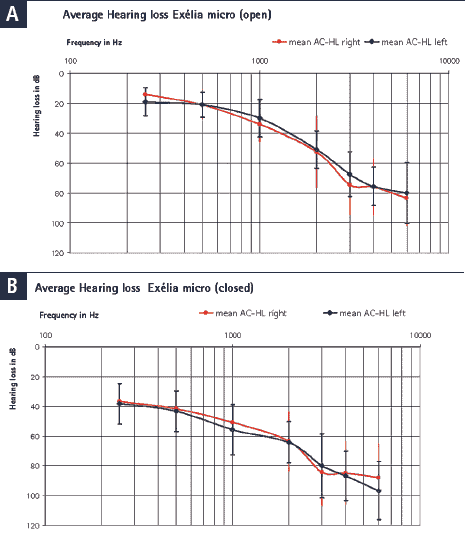
FIGURE 3. Averaged hearing loss of test participants for Exélia micro wearers which are open fitted (A) and those with a closed fitting (B). The hearing loss for closed-fitted Exélia micro wearers resembles also the hearing loss of Exélia Art ITC P wearers (B).
Click’nTalk was tested in comparison to EasyPhone, the automatic hearing instrument telephone program. The EasyPhone function enables the Phonak hearing aid to automatically select an accurate telephone program (t-coil or acoustic phone) when the telephone receiver is placed near the instrument. The devices were fitted according to Phonak’s recommendations. A precalculation based on the experience level of the test subjects and a feedback test were performed for all hearing aids.
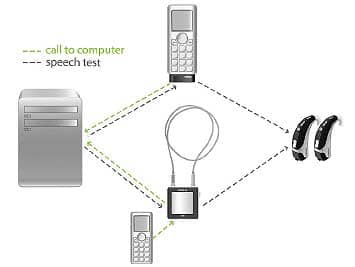
FIGURE 4. Test setup for assessing speech intelligibility with the mobile phone using Click’nTalk or the iCom.
To evaluate the benefits of the iCom, 16 experienced adult test subjects with a moderate-to-severe sensorineural hearing loss participated in the study. They were provided with binaural hearing instruments fitted with the default iPFG settings. iCom devices were paired with a Bluetooth-capable mobile phone. Once paired, the mobile phones connect automatically. Two issues were examined in this study:
1) The evaluation of speech intelligibility in noise via mobile phone together with hearing instruments;
2) Spontaneous acceptance, usability, and benefit of the iCom in daily life.
Assessing speech intelligibility with the mobile phone. To evaluate the benefits of Click’nTalk and iCom for mobile phones, in-house telephone speech tests were set up providing the Göttinger sentence test in noise via the mobile phone, comparing the hearing instruments with and without accessories. Adaptive measurements of the speech-reception threshold (SRT, or signal-to-noise ratio for 50% intelligibility) were performed with subjects using the ear they normally use for telephoning. With the mobile phone, subjects had to call the computer, which directly provided the speech and the speech-simulating noise via the mobile phone. For all measures, the same mobile phone was used with equal settings for loudness to avoid irregularities of the wireless mobile connection.
For the iCom, the spontaneous acceptance and the subjective evaluation in daily life were determined by various questionnaires, which were completed while the subjects were performing a phone call on a noisy street and in a noisy restaurant.
Results
Click’nTalk. In the described listening situation where subjects had to repeat the presented words, results showed that 86.4% of the closed fittings demonstrated improved speech intelligibility with Click’nTalk compared to the EasyPhone automatic telephone program (Figure 5). These results were further supported by the fact that, with Click’nTalk employed, 100% of the test subjects reported that they understood almost everything while listening to a speaking clock (Figure 6), but only 83% of test subjects understood almost everything with the aid of the EasyPhone program (17% understood half of the speaking clock).
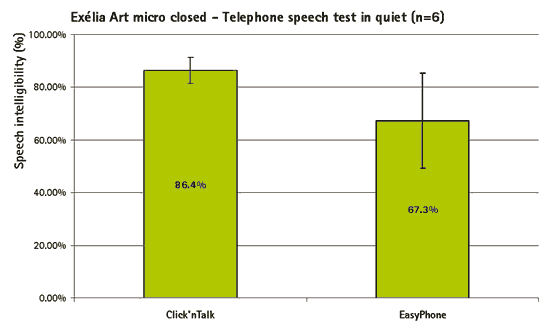
FIGURE 5. Benefits of Click’nTalk in the telephone speech test in quiet compared to the EasyPhone program when test subjects are closed fitted.

FIGURE 6. Speech intelligibility while listening to a speaking clock was 100% with the aid of Click’nTalk, and 83% for test participants using EasyPhone.
Evaluating speech intelligibility while listening to a weather forecast revealed that 100% of test subjects understood almost everything with the aid of Click’nTalk, while 83% reported they understood almost everything with the EasyPhone program. Overall, 80% of Exélia micro wearers with a closed fitting preferred Click’nTalk compared to EasyPhone.
The evaluation of Click’nTalk in combination with an open fitting of Exélia micro revealed 93.2% speech intelligibility with Click’nTalk in the telephone speech test in quiet compared to 69.7% speech intelligibility with the EasyPhone program (Figure 7). It is reasonable to assume that, with an open fitting, direct sound has a larger impact on the sound perception; thus, the results of the determination of speech intelligibility while listening to a weather forecast with Click’nTalk were somewhat less pronounced compared to the closed fittings. A total of 75% of test subjects reported to understand almost everything with the aid of Click’nTalk, while 78% reported to understand almost everything with the EasyPhone program. A total of 13% of test subjects understood most of the forecast with the aid of Click’nTalk, while 13% understood only a little of the forecast; almost one-quarter (22%) of the test participants understood most of the weather forecast with the aid of the EasyPhone program.
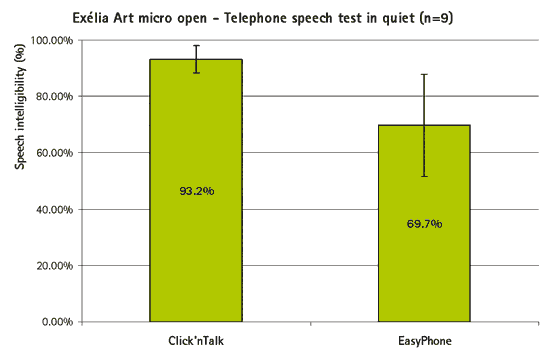
FIGURE 7. Speech intelligibility reached 93.2% with the aid of Click’nTalk, while speech understanding with EasyPhone resulted in 69.7%. Subjects were open fitted.

FIGURE 8. While listening to a speaking clock, 88% of the open-fitted test subjects understood “almost everything” and 13% “most” with the aid of Click’nTalk, while 89% understood almost everything and 11% most of the speaking clock with the aid of EasyPhone.
While listening to a speaking clock using Click’nTalk, 88% of the open-fitted subjects reported to understand almost everything, and 13% understood most of the speaking clock presentation. With the EasyPhone program, 89% of the subjects reported to understand almost everything, while 11% reported to understand most of the presentation (Figure 8).
Overall, 38% of the test subjects clearly preferred Click’nTalk compared to the EasyPhone program, while 13% of the subjects reported to have no preference, and 36% preferred another telephone program that was not evaluated in this test.
Results of Click’nTalk in combination with ITCs revealed that 89.6% of test subjects showed improved speech intelligibility in the telephone test in quiet compared to the EasyPhone program, which resulted in 78.6% of speech intelligibility (Figure 9). Speech intelligibility while listening to a speaking clock reached 100% with Click’nTalk, while only 86% of test subjects understood almost everything with EasyPhone (Figure 10).
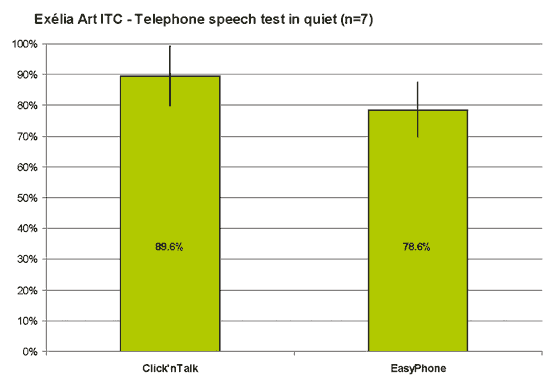
FIGURE 9. Benefits of Click’nTalk in the telephone speech test in quiet compared to the EasyPhone program when test subjects are fitted with an ITC.

FIGURE 10. Speech intelligibility while listening to a speaking clock using ITCs. With the aid of Click’nTalk, speech intelligibility reached 100%.
Spontaneous acceptance, usability, and benefit of the iCom in daily life. Compared to the reference measures without accessory, the iCom achieved a significant improvement of speech intelligibility in noise with the Göttinger sentence test via mobile phone (Figure 11).
To subjectively evaluate speech intelligibility in noise, subjects had to perform a phone call on a noisy street and in a noisy restaurant. They were then asked to rate speech intelligibility compared to their previous mobile solution. Results showed very good spontaneous acceptance of iCom overall. The handling of iCom was rated to be very easy, with 94% of test subjects rating the ringtone as very helpful, 82% reported having no interruptions during phone calls, and 1 test subject reported having interruptions during the call due to problems with the GSM. However, 69% of test subjects evaluated the iCom as being very helpful and 31% as helpful.
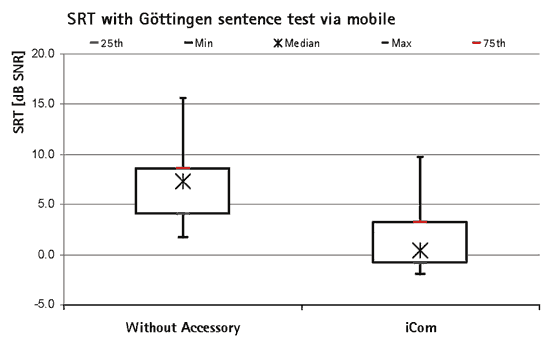
FIGURE 11. Improved speech intelligibility with the iCom in the Göttinger sentence test in noise compared to the hearing instrument only condition. Crosses highlight medians, rectangles represent 25% to 75% confidence interval, and vertical lines depict non-outlier ranges (*p<0.01).

FIGURE 12. Benefits of the iCom during a mobile phone call on a noisy street.
While performing a phone call next to a noisy street, 64% of subjects rated speech intelligibility as clearly improved compared to the previous solution for phone calls, and 36% rated it as improved (Figure 12). A total of 44% understood everything, 38% almost everything, and 1 test subject understood half of the communication compared to the previous solution. However, a recent study14 points out that, when interference of the phone with the hearing instrument occurs, the GSM noise can lead to speech understanding difficulties.
When making a phone call in a noisy restaurant, 62% of test subjects reported understanding clearly more than with the previous phone solution, 23% understood a little bit more, 8% equal, and 8% less than before. Further, 48% of test subjects understood everything, 48% mostly everything, and 8% reported understanding less of the conversation. However, the test subject with the negative rating reported that the mobile phone and the iCom were disconnected due to a distance in between them of more than 10 m. This was difficult to notice. The devices were not reconnected again automatically; it therefore might be a case in which the subject used an inactive iCom during the phone call.
Discussion
Until now, hearing instrument wearers had the option to perform mobile phone calls without hearing instruments, or using a telecoil, or using a special telephone program but always with the potential for feedback. While other solutions show problems related to distance and/or buzz, users now have the ability to use Click’nTalk or iCom, which provide a bilateral signal for significantly increased speech intelligibility in quiet and noise due to the stable HiBAN link between the accessories and the hearing instrument.
These accessories can be used for both CORE BTE and ITC devices. Click’nTalk simply needs to be clicked onto a mobile phone, and the iCom can be worn with a neck loop thereby providing hands-free telephone use. Furthermore, the easy handling of the iCom and the easy positioning of Click’nTalk lead to a fast spontaneous acceptance and a positive overall impression.
The studies presented here involving mobile phones indicate improved speech intelligibility in quiet and noise for first-time users of either Click’nTalk or iCom. These data are similar to a recent study published by Heichel and Lotter3 reporting improved speech intelligibility with the use of binaural wireless phones compared to monaural phones. Since test subjects were first-time users of these accessories, one can conclude that improvements in speech intelligibility may even increase after a short acclimatization. Heichel and Lotter3 further reported the benefits of binaural phones compared to acoustic telephone programs.
Although useful, many of the previous conventional approaches to telephone use involved a dependency on the exact position of the telephone receiver over the hearing instrument, and the resulting speech signal was only transmitted monaurally. In these systems, because of the positioning of the receiver over the hearing aid microphones, the possibility of feedback occurrence is higher. However, acoustic programs, such as EasyPhone, do not require additional equipment (except a magnet).
Our study shows that the binaural transmission of the signal with either Click’nTalk or the iCom clearly improves speech intelligibility in quiet and noise while using a mobile phone and enhances comfort.
With the aid of modern hearing aid technology, we believe the quality of life for hearing aid users has significantly improved4 by reducing the problems of feedback, distortion, insufficient volume, and speech understanding in noise. The integration of wireless communication applications combined with the flexibility and computational power of new chip designs has created a huge opportunity in terms of the solutions that can now be offered to people with hearing impairment so that they truly have hearing systems, not just hearing instruments.
References
- 1. Nielson et al. Portable telephone communication device for the hearing impaired. US Patent 4268721;1981.
- 2. Van Noorden L, Ekberg J. Integrated Broadband Communication (IBC) requirements of people with special needs. Int J Rehabil Res. 1990;13(2):137-49.
- 3. Heichel R, Lotter T. Hörgeräte integrierte funksysteme und ihr Nutzen für den kunden. Hörakustik. 2009;3:8-15.
- 4. Recker K, Kalluri S. Digital hearing aids and cell phones: the impact of new technology on phone use. Hearing Review. 2009;16(3):16-20.
- 5. American National Standards Institute (ANSI)/Telecommunications Industry Association (TIA). Handset Magnetic Measurement Procedures and Performance Requirements. ANSI/TIA-1083; 2007.
- 6. Alliance for Telecommunication Industry Solutions (ATIS), et al. Hearing Aid Compatibility with Digital Wireless Cell Phones: An Update for Audiologists, Physicians, and Hearing Instrument Specialists. 2006. Available at: files.ctia.org/pdf/Brochure_CTIA_Hearing_AidCompatibility_Audiologists.pdf.
- 6. Berger S. Hearing aid and cellular telephone compatibility: working toward solutions. J Am Acad Audiol. 2001;12:309-314.
- 7. Harkins J. Practical information for audiologists on access to wireless telephones. J Am Acad Audiol. 2001;12:290-300.
- 8. Levitt H. The nature of electromagnetic interference. J Am Acad Audiol. 2001;12:322-326.
- 9. Levitt H, Harkins J, Singer B, Yeung E. Field measurements of electromagnetic interference in hearing aids. J Am Acad Audiol. 2001;12:275-280.
- 10. Ross M. Wireless telephones and hearing aids: an overview. J Am Acad Audiol. 2001;12:286-289.
- 11. Schlegel R, Ravindran A, Raman S, Grant H. Wireless telephone-hearing aid electromagnetic compatibility research at the University of Oklahoma. J Am Acad Audiol. 2001;12:301-308.
- 12. Mormer E, Mack AM. Telephones across the life span: an issue for all. Sem Hear. 2003;24(1):1-16.
- 13. Kepler LJ, Terry M, Sweetman RH. Telephone usage in the hearing-impaired population. Amplif Aural Rehab. 1992;13(5):311-319.
- 14. Scopek M. Hearing aid electromagnetic interference from digital wireless telephones. IEEE Trans Rehab Engineering. 1998;6(2):235-39.
Citation for this article:
Nyffeler M, Dechant S. The impact of new technology on mobile phone use. Hearing Review. 2010;17(3):42-49.




